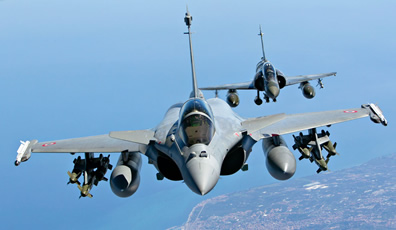
This is a page 3 of a three page article: 1 – 2 – 3
The Libyan campaign has emphasized unique advantages of the French AASM-250 autonomous guided weapons. Previously criticized in the media as an excessively expensive weapon, AASM proved its worth offering operational flexibility, in providing small fighting formations the effects achied by much larger strike forces. The weapon was developed to meet a wide range of offensive air missions, including Counter Air Defense/(Suppression of Enemy Air Defense – SEAD), Air Interdiction and Deep Strikes, and anti-ship missions, as well as Close Air Support (CAS) including precision attacks in urban environments.

Relying on the AASM extended stand-off range, the French Rafales were tasked to suppress and destroy Libyan SA-3 air defense sites during the initial phases of the conflict. During these strikes, Rafaeles utilized on-board sensor fusion, to integrate data obtained from on-board sensors and external sources, delivered over Link-16. This capability enabled pilots to generate strike coordinates based on real-time data, and feed it to the weapon in flight. The French fighters succeeded to hit the active sites with AASM, launching the weapons from long distance, outside the SA-3 launch envelope. Since each individual weapon is programmed with specific target coordinates, multiple weapons can be employed from the attacking aircraft, against different targets. Each weapon can be reprogrammed before launch, enabling it to engage several targets simultaneously.
A significant advantage of the AASM is the ability to retarget the weapon from the cockpit, just before launch. A Rafale carrying six weapons, each loaded with six different targets prior to takeoff. The pilot can select different targets for each weapon, or decide to engage the same target twice, in case the targets is not destroyed by the first strike. Such re-attack option increases mission success, by avoiding the high risk and costs involved with repeat missions, following battle damage assessment. Overall, Sagem claims a mission success rate of over 90%, compared to 70%, achieved by unpowered (gliding) laser guided or geo-targeted weapons. The later are have inherent limitations in mission planning, restricted by gliding envelope and laser designation ‘basket’ effecting flight envelope, trajectory, impact angle and penetration.
When employed against air defense assets, the combination of the weapon’s stand-off range and re-attack capability means an air defense site would be taken out of operation for longer periods, delivering higher success rate in SEAD operations and precision attacks of high value targets. Another important capability, particularly in today’s hybrid warfare, is the weapon’s flexibility in striking ‘time critical targets’. During the recent attacks in Libya, a Rafale pilot clearly demonstrated such method, when spotting a Libyan Soko G2 Galeb aircraft flying near Misrata. As the Libyan plane landed at the base, the Rafale pilot acquired its coordinates as a ‘target of opportunity’, fed the data to the weapon and launched the GPS/INS guided AASM against the target. As the weapon dropped, it homed in on the exact spot and destroyed the Libyan aircraft on the tarmac.

Operational with the French Air Force, and French Naval Aviation, AASM is produced made by Safran subsidiary Sagem DS. The weapon was first deployed in Afghanistan with the French Rafale in 2008. The baseline AASM kit comprises of the INS/GPS guidance system, designed for standard 250 kg (500 pounds) bombs. The AASM family will eventually include 125, 500 and 1,000 kg (250, 1000, and 2000 pounds) versions. Since the French forces have received only the initial deliveries of 3,500 weapons ordered, chances are that the used inventory could be replenished by extending current production runs. It is assumed that new weapons could be delivered at considerably lower costs than the original ones, as the manufacturer has stepped up the learning curve. Nevertheless, the cost of a basic AASM is still expected to remain around $300,000 a piece (€200,000).
The weapon uses a booster/sustainer rocket engine accelerating it to the designated cruising speed and altitude, from where it is designed to continue through an autonomous operation, in day or night and in all weather conditions. It can be released at low altitude, and can also be fired up to 180 degrees off-axis in relation to the aircraft’s flight path, (‘backwards’) attacking targets from any direction, from standoff distance exceeding 50 km.
AASM-250 weapons are currently fitted with inertial/GPS guidance. The addition of semi-active laser seeker, and algorithms to track fixed or mobile targets during the terminal phase, will enhance the operational flexibility of the AASM family. Two versions are currently available and undergoing qualification for firing by the Rafale multirole fighter – the inertial/GPS and soon to be fielded inertial/GPS/infrared. These optional terminal guidance kits are designed as ‘add-on’.
Currently under development, will increase attack precision and enable engagement of fast moving targets. The infra-red seeker enables the weapon to hit small targets with distinctive signature, overcoming target location errors y undertaking a terminal correction just before impact. The semi-active laser seeker, along with associated moving target algorithms enable engagement of any surface target (stationary or moving) illuminated by a target designator, even targets travelling at high speed. The laser terminal guidance version of the AASM is expected to enter volume production for the French air force and navy starting at the end of 2012.
The AASM-125 was successfully tested in February 2009 on a Mirage 2000. The AASM-1000 is under development, as are new features such as airburst and data link. The AASM has also been selected to equip the Moroccan Mirage F-1s and are considered a likely choice for Air Forces considering the French Rafale (India, Brazil). Sagem is also addressing other platforms as well, including opportunities to arm Mirage 2000s in foreign service.
















